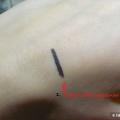A detailed analysis of the diet for joint pain: the rules for switching to clinical nutrition, the nuances of a quick recovery
In common foods such as pork, tomatoes, butter, contain inflammatory mediators . These substances lead to increased pain in the joints. Their exclusion from the diet allows you to accelerate the restoration of cartilage, enhance the effect of conservative therapy. Adding foods that are unusual for most people, such as fresh pomegranate or garlic, can suppress inflammation and reduce the intensity of joint pain.
Compliance with a therapeutic diet reduces the likelihood of exacerbation of inflammatory processes in the joint by 50-60%, and the severity of the pain syndrome can be reduced by 2-3 times.
Diet Benefits
Joint pain is the result of two phenomena - inflammation and cartilage degeneration. These problems can be significantly influenced by following a special diet.
The beneficial effects of following a diet for joint pain include:
Refusing fatty foods, salt and alcohol, you can achieve a significant reduction in pain in the joints. The swelling of soft tissues in the projection of suffering joints will gradually disappear, their active and passive mobility will significantly improve. This phenomenon is due to the high concentration of inflammatory mediators and their precursors in these products.
In addition, you can influence edema with the help of giving up salt. According to the concentration gradient law, when the body is saturated with sodium chloride, the liquid begins to accumulate in the soft tissues and vascular bed. As a result, the load on the heart increases (hypertension develops), kidneys and lymphatic system (edema appears).
The second mechanism for the appearance of pain in the joints is the degeneration of the articular surfaces. This condition develops due to malnutrition. Young people are in a compensated state due to the regenerative abilities of the body. In older patients, there is a lack of intake of calcium, phosphorus and vitamin D. This is due to malnutrition and deterioration of the adsorbing properties of the small intestine.

Beneficial intestinal microflora
Imbalance of the normal microflora in the loops of the small intestine leads to a deterioration in the absorption of substances necessary for the normal functioning of the musculoskeletal system.
Young patients suffering from joint pain should eat dairy products contributing to the restoration of the bacterial flora. In older patients, it is much more difficult to achieve recovery, so they are forced to compensate for this condition by taking increased doses of biologically active substances (vitamins) and minerals.
Vitamins and microelements necessary for older patients include:
- vitamins A, B5, B6, C, D3, E, K2, PP;
- calcium;
- phosphorus;
- chondroitin;
- collagen;
- glucosamine;
- selenium;
- silicon;
- manganese;
- hyaluronic acid.
It is more effective to take medicines containing in their composition a balanced complex of these substances: Vitrum Osteomag, Calcemin Advance, ArtriVit.
Principles
A nutritionist will help you choose the right diet for joint pain. It takes into account the data of laboratory tests, instrumental diagnostics and physical examination. After establishing the cause of pain in the joints, a dietary diet is developed.
The principles of the diet inflammatory pain etiology:
- reduction in daily calorie intake to 2300 kcal per day;
- meals in portions of 150-200 g 5-7 times a day;
- refusal of products containing pro-inflammatory agents (pork, alcohol, monosodium glutamate, fast food, smoked meats);
- increase in daily consumption of clean water up to 2 liters;
- reducing salt intake to 2–3 g per day;
- refusal of alcohol and fatty foods;
- saturation of the diet with plant foods.
Availability degenerative pains requires adherence to such dietary principles:
- fractional meals 5-6 times a day in small portions (divide the daily calorie intake by the indicated number of meals);
- daily use of kefir (0–1% fat content) or cottage cheese (0–6%);
- refusal of fast carbohydrates (sugar, bakery products);
- saturation of the diet with vitamins, calcium salts and phosphorus of natural or synthetic origin.
What you need to eat so that the joints, bones and muscles do not hurt
The following products contain substances useful for the joints. They are rich in high-density lipoproteins, omega-3 fatty acids, gelatin and phytoncides. Their use favorably affects the health of the musculoskeletal system, and also allows you to save the patient from pain in the joints.

Jelly for joint pain

What not to eat: a list of prohibited foods
Some products can stimulate the manifestation of pain in the joints. This is due to the high concentration of histamine, bradykinin, prostaglandins and interleukins that regulate inflammation in the body.
Such products include:
- sugar;
- salt;
- monosodium glutamate;
- coffee;
- pork;
- smoked meats;
- canned food;
- fast food.
Nutritionists recommend completely eliminating the presented products from the diet for joint pain. Compliance with such a diet will significantly increase the effectiveness of drug therapy, as well as make progress in prevention.
What vitamins to supplement the diet if the joints of the arms and legs hurt
Vitamins play an important role in the treatment of joint pain. In case of their deficiency, the processes of restoration of the cartilaginous plate are disrupted, and inflammatory diseases are activated for the second time. Getting enough vitamins through food is difficult. This requires a complete diet, the normal functioning of the digestive tract, the absence of chronic diseases of the endocrine system.
To compensate for the insufficient intake of these biological substances, doctors recommend taking vitamin supplements.
To speed up the process of joint recovery, as well as get rid of pain in them, it is recommended to take such vitamins:

In addition to vitamins, various microelements and organic substances influence the processes of joint recovery in case of pain. The diet should be aimed at increasing the intake of the following elements in the patient's body:
- chondroitin;
- collagen;
- glucosamine;
- manganese;
- sulfur;
- silicon;
- selenium.
The list of the most popular vitamin and mineral complexes include:
- Vitamin D-3, High Potency by Now Foods;
- 3-in-1 Joint Formula by Irwin Naturals;
- Calcium with Vitamin D3 by Nature Made.
Each of the listed medicines contains in the composition of one capsule the daily norm of substances necessary for the joints. You need to take the medicine once, drinking plenty of water with meals.
Diet example for 7 days
Patients are often intimidated by the prospect of dieting. The imposed stereotype mentally refers a person to significant restrictions, a meager and monotonous diet. Professional nutritionists are those specialists who will select a complete and tasty set of dishes.
In order for food to be better absorbed, it should be subjected to good heat treatment by boiling, stewing, steaming or baking.
Consider a detailed diet for joint pain of an inflammatory or degenerative nature for 7 days. Portions should be no more than 200 g, daily energy value - within 2300 kcal, and the amount of water consumed is at least one and a half liters.
- salad - 150–200 g;
- soup - 350–400 ml;
- porridge - 300-400 g;
- puree - 250-350 g;
- meat - 150–180 g;
- fish - 150–180 g;
- cottage cheese - 150–200 g;
- jelly / jelly - 150–200 g.
| Breakfast | Snack | Dinner | Snack | Dinner | |
| 1st day |
|
|
|
|
|
| 2nd day |
|
|
|
|
|
| 3rd day |
|
|
|
|
|
| 4th day |
|
|
|
|
|
| 5th day |
|
|
|
|
|
| 6th day |
|
|
|
|
|
| 7th day |
|
|
|
|
|
Results: what postulates of treatment must be observed
- A diet for joint pain is effective in the inflammatory and degenerative nature of the disease.
- To select a complete diet, you need to contact a specialist.
- It is necessary to abandon fatty meats, alcohol, smoked meats and flavor enhancers (monosodium glutamate, sugar, salt).
- The daily energy value for the duration of the diet is reduced to 2300 kcal.
- Meals should be fractional and frequent (servings of 200–250 g, 5–6 times a day).
- It is recommended to supplement the diet with vitamin complexes and nutritional supplements for the joints.
- The best effect in the treatment of joint pain is achieved by combining pharmacotherapy, diet and exercise therapy.
 How to have the perfect date if you're not a romantic
How to have the perfect date if you're not a romantic For what diseases you need to drink coffee - the benefits and effects
For what diseases you need to drink coffee - the benefits and effects All my brown eyeliners
All my brown eyeliners